Child Well-being in Social Work: Public Health, Abuse, and Strategies
VerifiedAdded on 2023/06/07
|13
|3677
|92
Report
AI Summary
This report examines various aspects of child well-being from a social work perspective, focusing on the advantages and disadvantages of a public health approach, different types of child abuse (physical, emotional, neglect, sexual, and exposure to family violence), and the success of Australian government strategies like the Aboriginal Community Controlled Health Services (ACCHSs). It also addresses challenges such as differing views on bullying in schools and the importance of communication, analytical, and negotiation skills in targeted interventions. The report further analyzes scenarios involving desperation, emotional abuse, domestic violence, child neglect, and stubbornness, suggesting appropriate support mechanisms. Sociological theory is discussed in relation to its benefits in decision-making for specific populations, highlighting the significance of informed interventions and comprehensive understanding in promoting child welfare.

Running head: Bachelor in social work 1
Bachelor in social work
By:
Student ID:
Course No:
Tutor:
Date:
Bachelor in social work
By:
Student ID:
Course No:
Tutor:
Date:
Paraphrase This Document
Need a fresh take? Get an instant paraphrase of this document with our AI Paraphraser
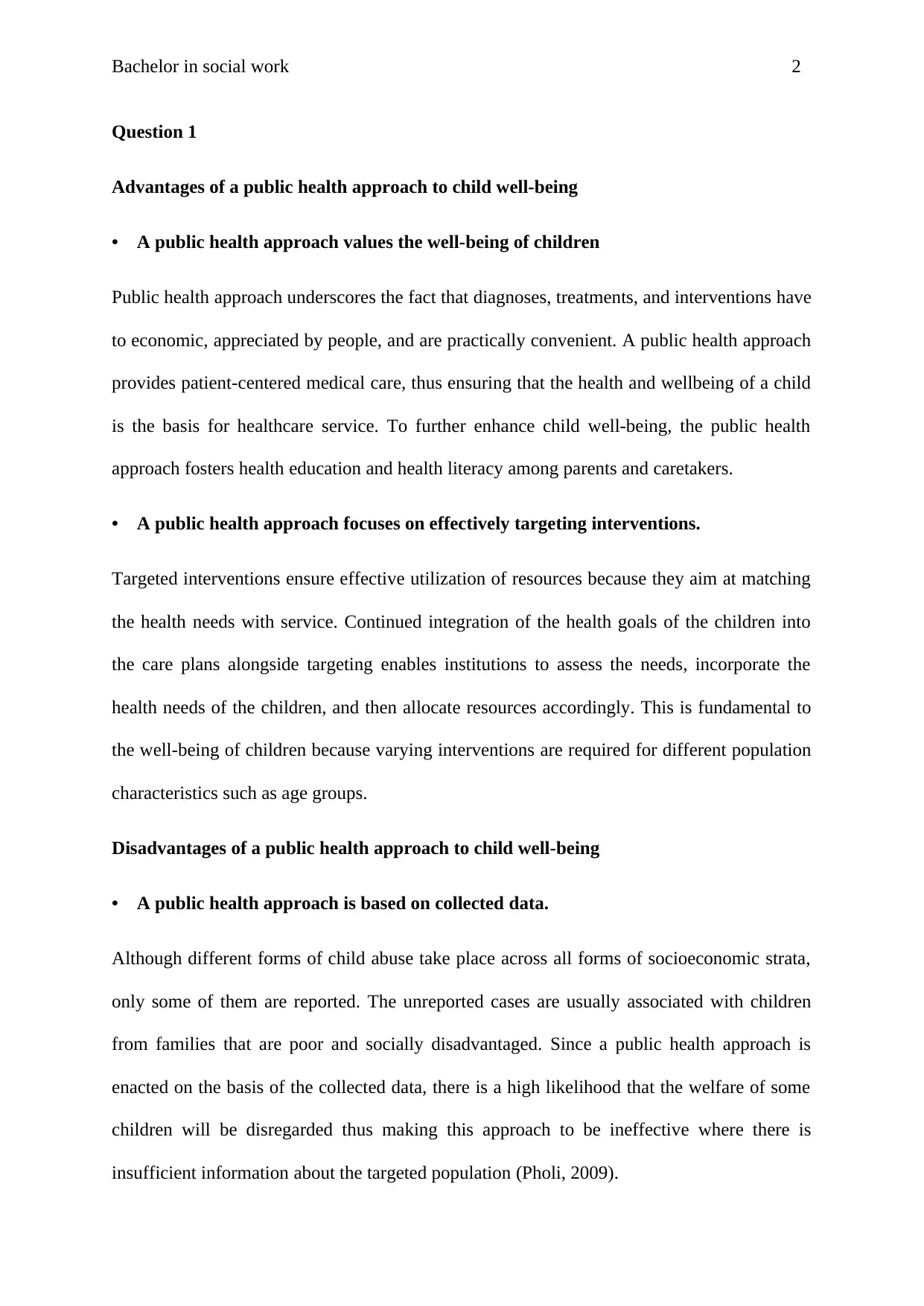
Bachelor in social work 2
Question 1
Advantages of a public health approach to child well-being
• A public health approach values the well-being of children
Public health approach underscores the fact that diagnoses, treatments, and interventions have
to economic, appreciated by people, and are practically convenient. A public health approach
provides patient-centered medical care, thus ensuring that the health and wellbeing of a child
is the basis for healthcare service. To further enhance child well-being, the public health
approach fosters health education and health literacy among parents and caretakers.
• A public health approach focuses on effectively targeting interventions.
Targeted interventions ensure effective utilization of resources because they aim at matching
the health needs with service. Continued integration of the health goals of the children into
the care plans alongside targeting enables institutions to assess the needs, incorporate the
health needs of the children, and then allocate resources accordingly. This is fundamental to
the well-being of children because varying interventions are required for different population
characteristics such as age groups.
Disadvantages of a public health approach to child well-being
• A public health approach is based on collected data.
Although different forms of child abuse take place across all forms of socioeconomic strata,
only some of them are reported. The unreported cases are usually associated with children
from families that are poor and socially disadvantaged. Since a public health approach is
enacted on the basis of the collected data, there is a high likelihood that the welfare of some
children will be disregarded thus making this approach to be ineffective where there is
insufficient information about the targeted population (Pholi, 2009).
Question 1
Advantages of a public health approach to child well-being
• A public health approach values the well-being of children
Public health approach underscores the fact that diagnoses, treatments, and interventions have
to economic, appreciated by people, and are practically convenient. A public health approach
provides patient-centered medical care, thus ensuring that the health and wellbeing of a child
is the basis for healthcare service. To further enhance child well-being, the public health
approach fosters health education and health literacy among parents and caretakers.
• A public health approach focuses on effectively targeting interventions.
Targeted interventions ensure effective utilization of resources because they aim at matching
the health needs with service. Continued integration of the health goals of the children into
the care plans alongside targeting enables institutions to assess the needs, incorporate the
health needs of the children, and then allocate resources accordingly. This is fundamental to
the well-being of children because varying interventions are required for different population
characteristics such as age groups.
Disadvantages of a public health approach to child well-being
• A public health approach is based on collected data.
Although different forms of child abuse take place across all forms of socioeconomic strata,
only some of them are reported. The unreported cases are usually associated with children
from families that are poor and socially disadvantaged. Since a public health approach is
enacted on the basis of the collected data, there is a high likelihood that the welfare of some
children will be disregarded thus making this approach to be ineffective where there is
insufficient information about the targeted population (Pholi, 2009).
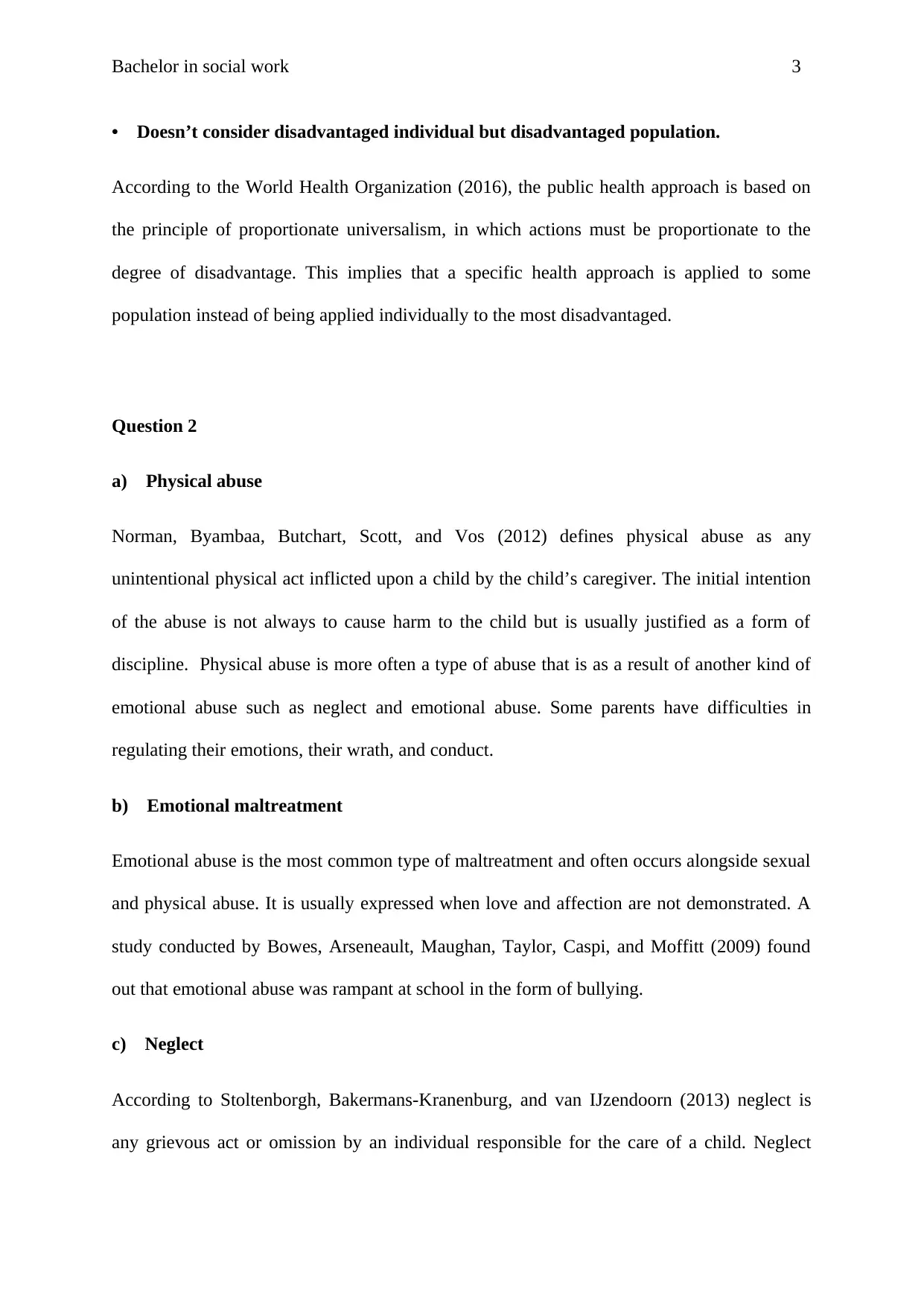
Bachelor in social work 3
• Doesn’t consider disadvantaged individual but disadvantaged population.
According to the World Health Organization (2016), the public health approach is based on
the principle of proportionate universalism, in which actions must be proportionate to the
degree of disadvantage. This implies that a specific health approach is applied to some
population instead of being applied individually to the most disadvantaged.
Question 2
a) Physical abuse
Norman, Byambaa, Butchart, Scott, and Vos (2012) defines physical abuse as any
unintentional physical act inflicted upon a child by the child’s caregiver. The initial intention
of the abuse is not always to cause harm to the child but is usually justified as a form of
discipline. Physical abuse is more often a type of abuse that is as a result of another kind of
emotional abuse such as neglect and emotional abuse. Some parents have difficulties in
regulating their emotions, their wrath, and conduct.
b) Emotional maltreatment
Emotional abuse is the most common type of maltreatment and often occurs alongside sexual
and physical abuse. It is usually expressed when love and affection are not demonstrated. A
study conducted by Bowes, Arseneault, Maughan, Taylor, Caspi, and Moffitt (2009) found
out that emotional abuse was rampant at school in the form of bullying.
c) Neglect
According to Stoltenborgh, Bakermans-Kranenburg, and van IJzendoorn (2013) neglect is
any grievous act or omission by an individual responsible for the care of a child. Neglect
• Doesn’t consider disadvantaged individual but disadvantaged population.
According to the World Health Organization (2016), the public health approach is based on
the principle of proportionate universalism, in which actions must be proportionate to the
degree of disadvantage. This implies that a specific health approach is applied to some
population instead of being applied individually to the most disadvantaged.
Question 2
a) Physical abuse
Norman, Byambaa, Butchart, Scott, and Vos (2012) defines physical abuse as any
unintentional physical act inflicted upon a child by the child’s caregiver. The initial intention
of the abuse is not always to cause harm to the child but is usually justified as a form of
discipline. Physical abuse is more often a type of abuse that is as a result of another kind of
emotional abuse such as neglect and emotional abuse. Some parents have difficulties in
regulating their emotions, their wrath, and conduct.
b) Emotional maltreatment
Emotional abuse is the most common type of maltreatment and often occurs alongside sexual
and physical abuse. It is usually expressed when love and affection are not demonstrated. A
study conducted by Bowes, Arseneault, Maughan, Taylor, Caspi, and Moffitt (2009) found
out that emotional abuse was rampant at school in the form of bullying.
c) Neglect
According to Stoltenborgh, Bakermans-Kranenburg, and van IJzendoorn (2013) neglect is
any grievous act or omission by an individual responsible for the care of a child. Neglect
⊘ This is a preview!⊘
Do you want full access?
Subscribe today to unlock all pages.

Trusted by 1+ million students worldwide
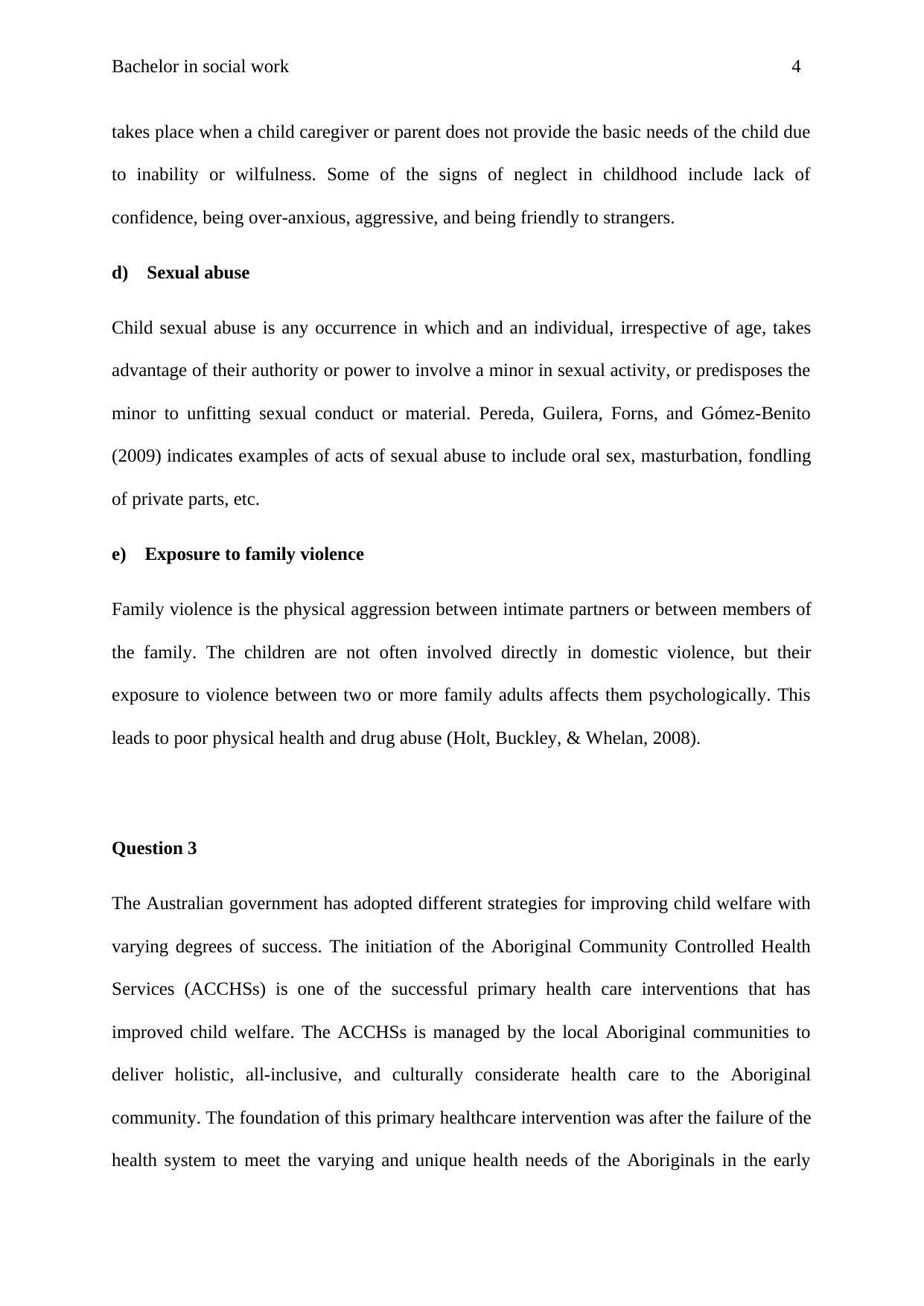
Bachelor in social work 4
takes place when a child caregiver or parent does not provide the basic needs of the child due
to inability or wilfulness. Some of the signs of neglect in childhood include lack of
confidence, being over-anxious, aggressive, and being friendly to strangers.
d) Sexual abuse
Child sexual abuse is any occurrence in which and an individual, irrespective of age, takes
advantage of their authority or power to involve a minor in sexual activity, or predisposes the
minor to unfitting sexual conduct or material. Pereda, Guilera, Forns, and Gómez-Benito
(2009) indicates examples of acts of sexual abuse to include oral sex, masturbation, fondling
of private parts, etc.
e) Exposure to family violence
Family violence is the physical aggression between intimate partners or between members of
the family. The children are not often involved directly in domestic violence, but their
exposure to violence between two or more family adults affects them psychologically. This
leads to poor physical health and drug abuse (Holt, Buckley, & Whelan, 2008).
Question 3
The Australian government has adopted different strategies for improving child welfare with
varying degrees of success. The initiation of the Aboriginal Community Controlled Health
Services (ACCHSs) is one of the successful primary health care interventions that has
improved child welfare. The ACCHSs is managed by the local Aboriginal communities to
deliver holistic, all-inclusive, and culturally considerate health care to the Aboriginal
community. The foundation of this primary healthcare intervention was after the failure of the
health system to meet the varying and unique health needs of the Aboriginals in the early
takes place when a child caregiver or parent does not provide the basic needs of the child due
to inability or wilfulness. Some of the signs of neglect in childhood include lack of
confidence, being over-anxious, aggressive, and being friendly to strangers.
d) Sexual abuse
Child sexual abuse is any occurrence in which and an individual, irrespective of age, takes
advantage of their authority or power to involve a minor in sexual activity, or predisposes the
minor to unfitting sexual conduct or material. Pereda, Guilera, Forns, and Gómez-Benito
(2009) indicates examples of acts of sexual abuse to include oral sex, masturbation, fondling
of private parts, etc.
e) Exposure to family violence
Family violence is the physical aggression between intimate partners or between members of
the family. The children are not often involved directly in domestic violence, but their
exposure to violence between two or more family adults affects them psychologically. This
leads to poor physical health and drug abuse (Holt, Buckley, & Whelan, 2008).
Question 3
The Australian government has adopted different strategies for improving child welfare with
varying degrees of success. The initiation of the Aboriginal Community Controlled Health
Services (ACCHSs) is one of the successful primary health care interventions that has
improved child welfare. The ACCHSs is managed by the local Aboriginal communities to
deliver holistic, all-inclusive, and culturally considerate health care to the Aboriginal
community. The foundation of this primary healthcare intervention was after the failure of the
health system to meet the varying and unique health needs of the Aboriginals in the early
Paraphrase This Document
Need a fresh take? Get an instant paraphrase of this document with our AI Paraphraser
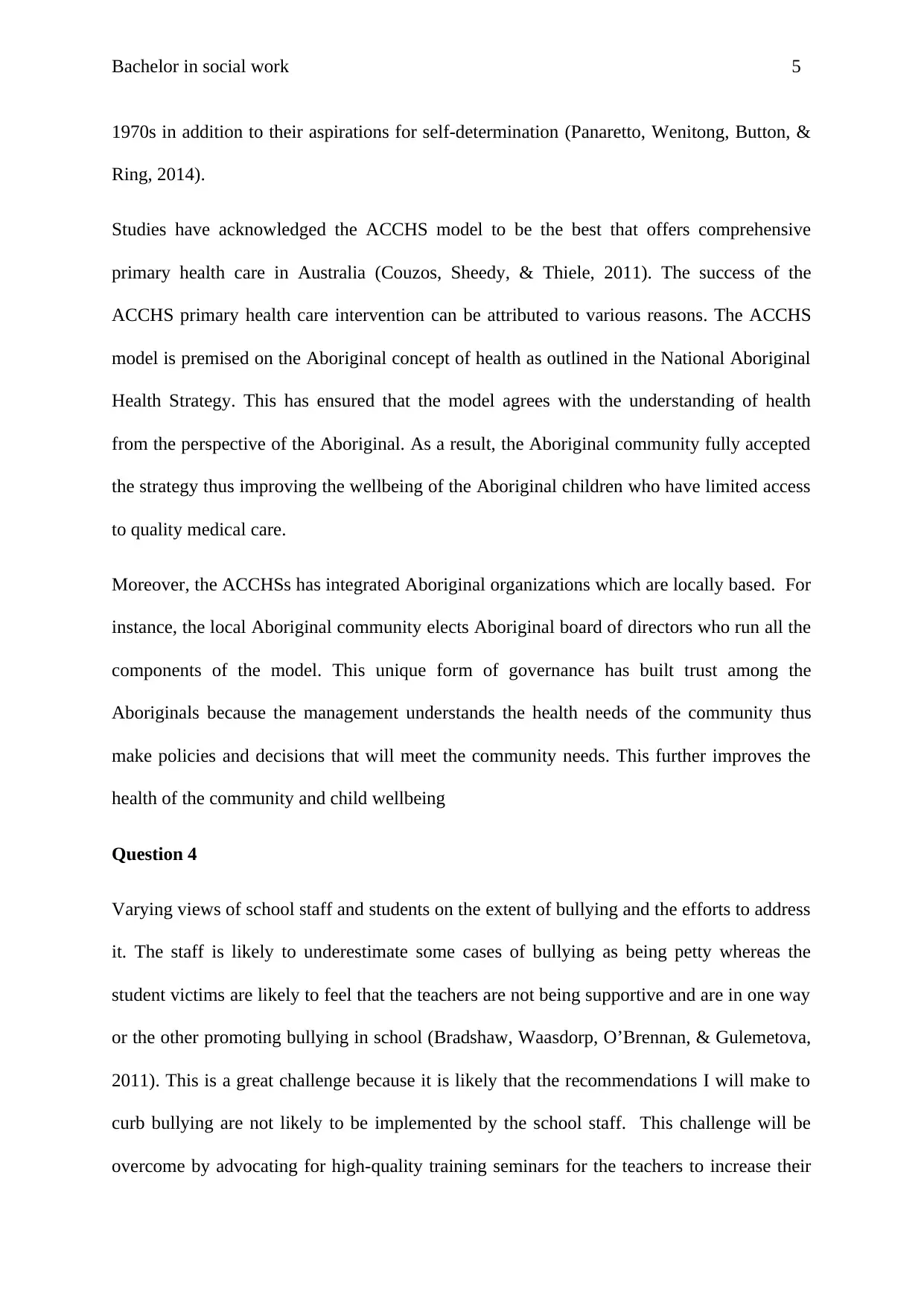
Bachelor in social work 5
1970s in addition to their aspirations for self-determination (Panaretto, Wenitong, Button, &
Ring, 2014).
Studies have acknowledged the ACCHS model to be the best that offers comprehensive
primary health care in Australia (Couzos, Sheedy, & Thiele, 2011). The success of the
ACCHS primary health care intervention can be attributed to various reasons. The ACCHS
model is premised on the Aboriginal concept of health as outlined in the National Aboriginal
Health Strategy. This has ensured that the model agrees with the understanding of health
from the perspective of the Aboriginal. As a result, the Aboriginal community fully accepted
the strategy thus improving the wellbeing of the Aboriginal children who have limited access
to quality medical care.
Moreover, the ACCHSs has integrated Aboriginal organizations which are locally based. For
instance, the local Aboriginal community elects Aboriginal board of directors who run all the
components of the model. This unique form of governance has built trust among the
Aboriginals because the management understands the health needs of the community thus
make policies and decisions that will meet the community needs. This further improves the
health of the community and child wellbeing
Question 4
Varying views of school staff and students on the extent of bullying and the efforts to address
it. The staff is likely to underestimate some cases of bullying as being petty whereas the
student victims are likely to feel that the teachers are not being supportive and are in one way
or the other promoting bullying in school (Bradshaw, Waasdorp, O’Brennan, & Gulemetova,
2011). This is a great challenge because it is likely that the recommendations I will make to
curb bullying are not likely to be implemented by the school staff. This challenge will be
overcome by advocating for high-quality training seminars for the teachers to increase their
1970s in addition to their aspirations for self-determination (Panaretto, Wenitong, Button, &
Ring, 2014).
Studies have acknowledged the ACCHS model to be the best that offers comprehensive
primary health care in Australia (Couzos, Sheedy, & Thiele, 2011). The success of the
ACCHS primary health care intervention can be attributed to various reasons. The ACCHS
model is premised on the Aboriginal concept of health as outlined in the National Aboriginal
Health Strategy. This has ensured that the model agrees with the understanding of health
from the perspective of the Aboriginal. As a result, the Aboriginal community fully accepted
the strategy thus improving the wellbeing of the Aboriginal children who have limited access
to quality medical care.
Moreover, the ACCHSs has integrated Aboriginal organizations which are locally based. For
instance, the local Aboriginal community elects Aboriginal board of directors who run all the
components of the model. This unique form of governance has built trust among the
Aboriginals because the management understands the health needs of the community thus
make policies and decisions that will meet the community needs. This further improves the
health of the community and child wellbeing
Question 4
Varying views of school staff and students on the extent of bullying and the efforts to address
it. The staff is likely to underestimate some cases of bullying as being petty whereas the
student victims are likely to feel that the teachers are not being supportive and are in one way
or the other promoting bullying in school (Bradshaw, Waasdorp, O’Brennan, & Gulemetova,
2011). This is a great challenge because it is likely that the recommendations I will make to
curb bullying are not likely to be implemented by the school staff. This challenge will be
overcome by advocating for high-quality training seminars for the teachers to increase their
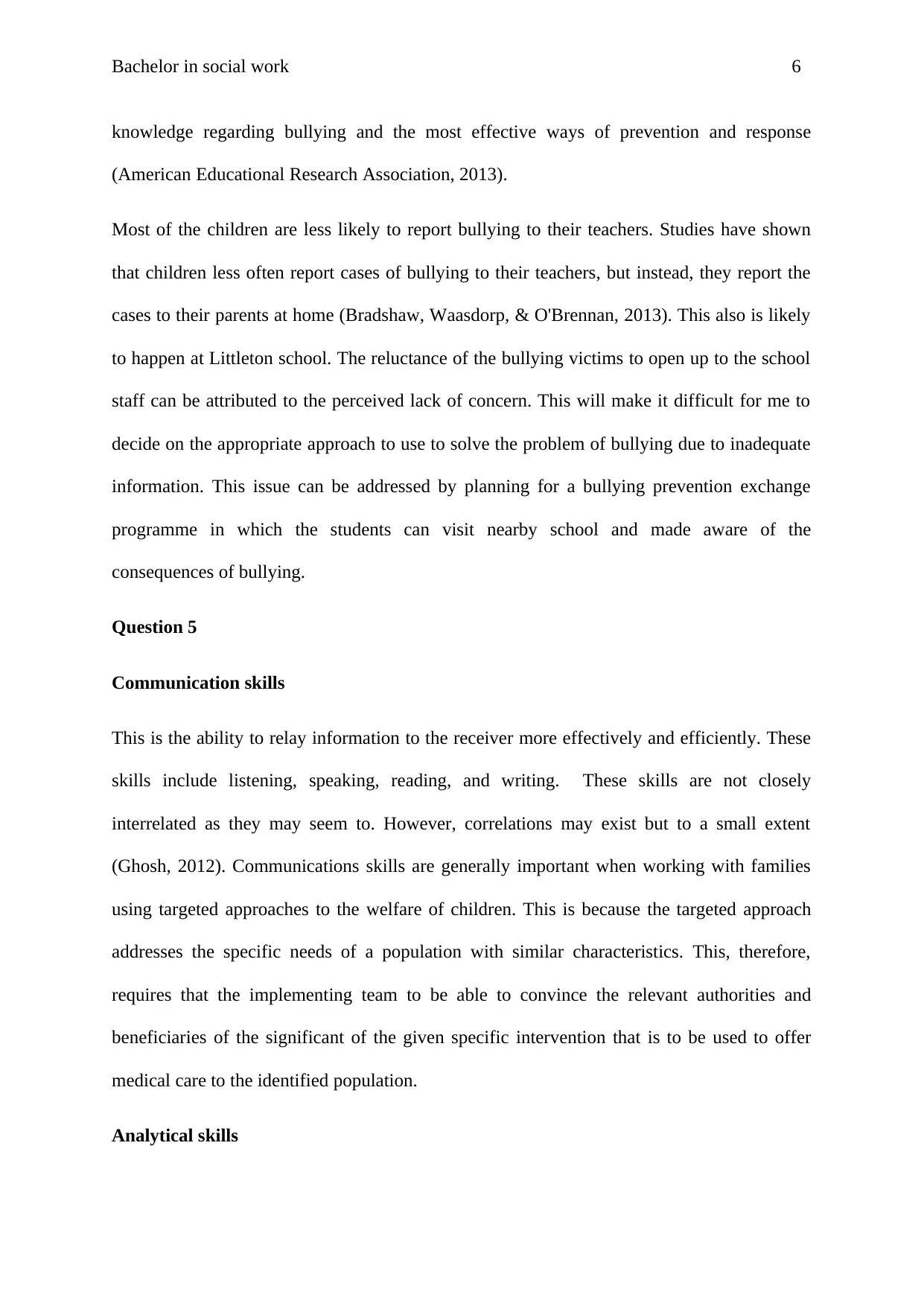
Bachelor in social work 6
knowledge regarding bullying and the most effective ways of prevention and response
(American Educational Research Association, 2013).
Most of the children are less likely to report bullying to their teachers. Studies have shown
that children less often report cases of bullying to their teachers, but instead, they report the
cases to their parents at home (Bradshaw, Waasdorp, & O'Brennan, 2013). This also is likely
to happen at Littleton school. The reluctance of the bullying victims to open up to the school
staff can be attributed to the perceived lack of concern. This will make it difficult for me to
decide on the appropriate approach to use to solve the problem of bullying due to inadequate
information. This issue can be addressed by planning for a bullying prevention exchange
programme in which the students can visit nearby school and made aware of the
consequences of bullying.
Question 5
Communication skills
This is the ability to relay information to the receiver more effectively and efficiently. These
skills include listening, speaking, reading, and writing. These skills are not closely
interrelated as they may seem to. However, correlations may exist but to a small extent
(Ghosh, 2012). Communications skills are generally important when working with families
using targeted approaches to the welfare of children. This is because the targeted approach
addresses the specific needs of a population with similar characteristics. This, therefore,
requires that the implementing team to be able to convince the relevant authorities and
beneficiaries of the significant of the given specific intervention that is to be used to offer
medical care to the identified population.
Analytical skills
knowledge regarding bullying and the most effective ways of prevention and response
(American Educational Research Association, 2013).
Most of the children are less likely to report bullying to their teachers. Studies have shown
that children less often report cases of bullying to their teachers, but instead, they report the
cases to their parents at home (Bradshaw, Waasdorp, & O'Brennan, 2013). This also is likely
to happen at Littleton school. The reluctance of the bullying victims to open up to the school
staff can be attributed to the perceived lack of concern. This will make it difficult for me to
decide on the appropriate approach to use to solve the problem of bullying due to inadequate
information. This issue can be addressed by planning for a bullying prevention exchange
programme in which the students can visit nearby school and made aware of the
consequences of bullying.
Question 5
Communication skills
This is the ability to relay information to the receiver more effectively and efficiently. These
skills include listening, speaking, reading, and writing. These skills are not closely
interrelated as they may seem to. However, correlations may exist but to a small extent
(Ghosh, 2012). Communications skills are generally important when working with families
using targeted approaches to the welfare of children. This is because the targeted approach
addresses the specific needs of a population with similar characteristics. This, therefore,
requires that the implementing team to be able to convince the relevant authorities and
beneficiaries of the significant of the given specific intervention that is to be used to offer
medical care to the identified population.
Analytical skills
⊘ This is a preview!⊘
Do you want full access?
Subscribe today to unlock all pages.

Trusted by 1+ million students worldwide
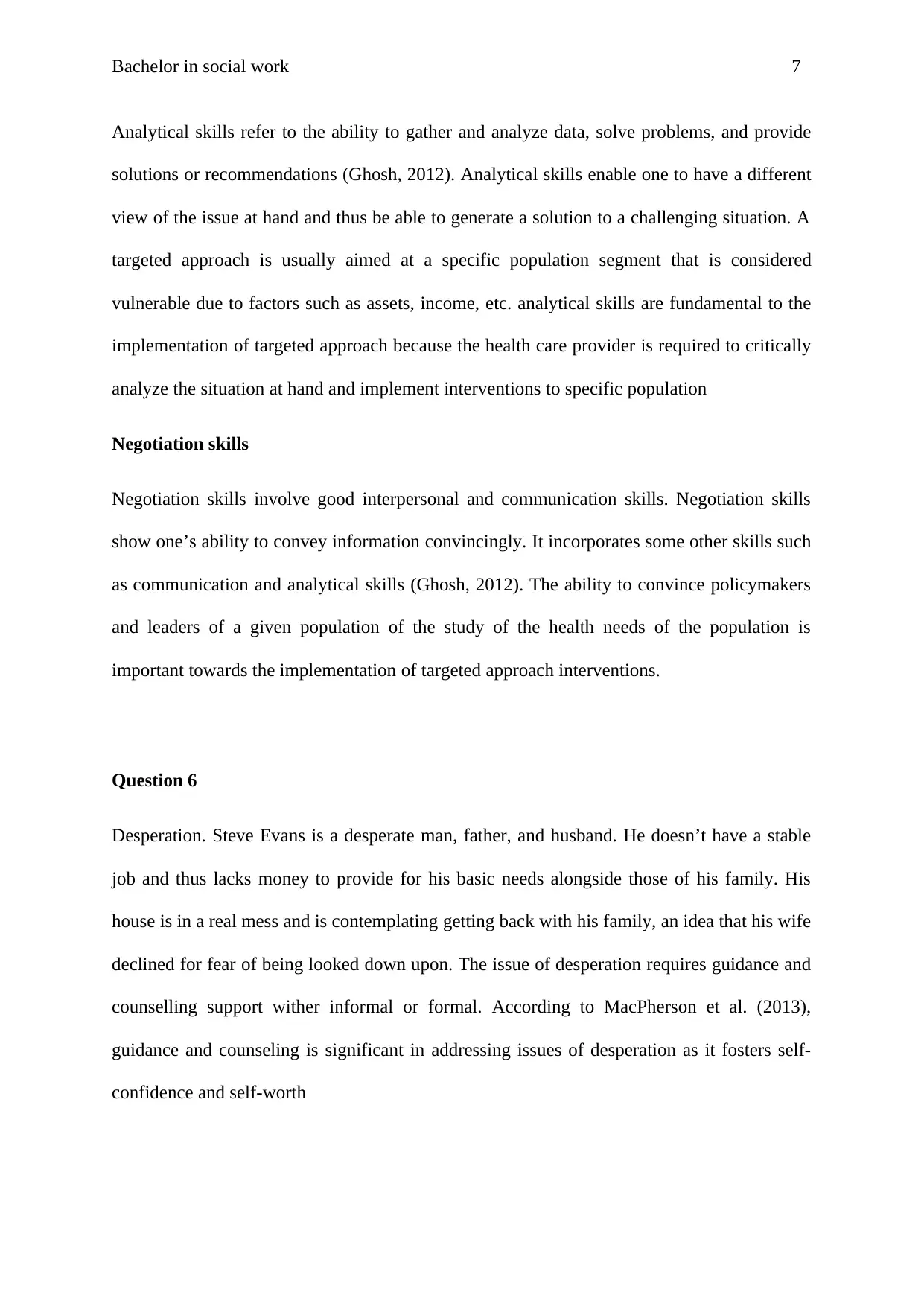
Bachelor in social work 7
Analytical skills refer to the ability to gather and analyze data, solve problems, and provide
solutions or recommendations (Ghosh, 2012). Analytical skills enable one to have a different
view of the issue at hand and thus be able to generate a solution to a challenging situation. A
targeted approach is usually aimed at a specific population segment that is considered
vulnerable due to factors such as assets, income, etc. analytical skills are fundamental to the
implementation of targeted approach because the health care provider is required to critically
analyze the situation at hand and implement interventions to specific population
Negotiation skills
Negotiation skills involve good interpersonal and communication skills. Negotiation skills
show one’s ability to convey information convincingly. It incorporates some other skills such
as communication and analytical skills (Ghosh, 2012). The ability to convince policymakers
and leaders of a given population of the study of the health needs of the population is
important towards the implementation of targeted approach interventions.
Question 6
Desperation. Steve Evans is a desperate man, father, and husband. He doesn’t have a stable
job and thus lacks money to provide for his basic needs alongside those of his family. His
house is in a real mess and is contemplating getting back with his family, an idea that his wife
declined for fear of being looked down upon. The issue of desperation requires guidance and
counselling support wither informal or formal. According to MacPherson et al. (2013),
guidance and counseling is significant in addressing issues of desperation as it fosters self-
confidence and self-worth
Analytical skills refer to the ability to gather and analyze data, solve problems, and provide
solutions or recommendations (Ghosh, 2012). Analytical skills enable one to have a different
view of the issue at hand and thus be able to generate a solution to a challenging situation. A
targeted approach is usually aimed at a specific population segment that is considered
vulnerable due to factors such as assets, income, etc. analytical skills are fundamental to the
implementation of targeted approach because the health care provider is required to critically
analyze the situation at hand and implement interventions to specific population
Negotiation skills
Negotiation skills involve good interpersonal and communication skills. Negotiation skills
show one’s ability to convey information convincingly. It incorporates some other skills such
as communication and analytical skills (Ghosh, 2012). The ability to convince policymakers
and leaders of a given population of the study of the health needs of the population is
important towards the implementation of targeted approach interventions.
Question 6
Desperation. Steve Evans is a desperate man, father, and husband. He doesn’t have a stable
job and thus lacks money to provide for his basic needs alongside those of his family. His
house is in a real mess and is contemplating getting back with his family, an idea that his wife
declined for fear of being looked down upon. The issue of desperation requires guidance and
counselling support wither informal or formal. According to MacPherson et al. (2013),
guidance and counseling is significant in addressing issues of desperation as it fosters self-
confidence and self-worth
Paraphrase This Document
Need a fresh take? Get an instant paraphrase of this document with our AI Paraphraser
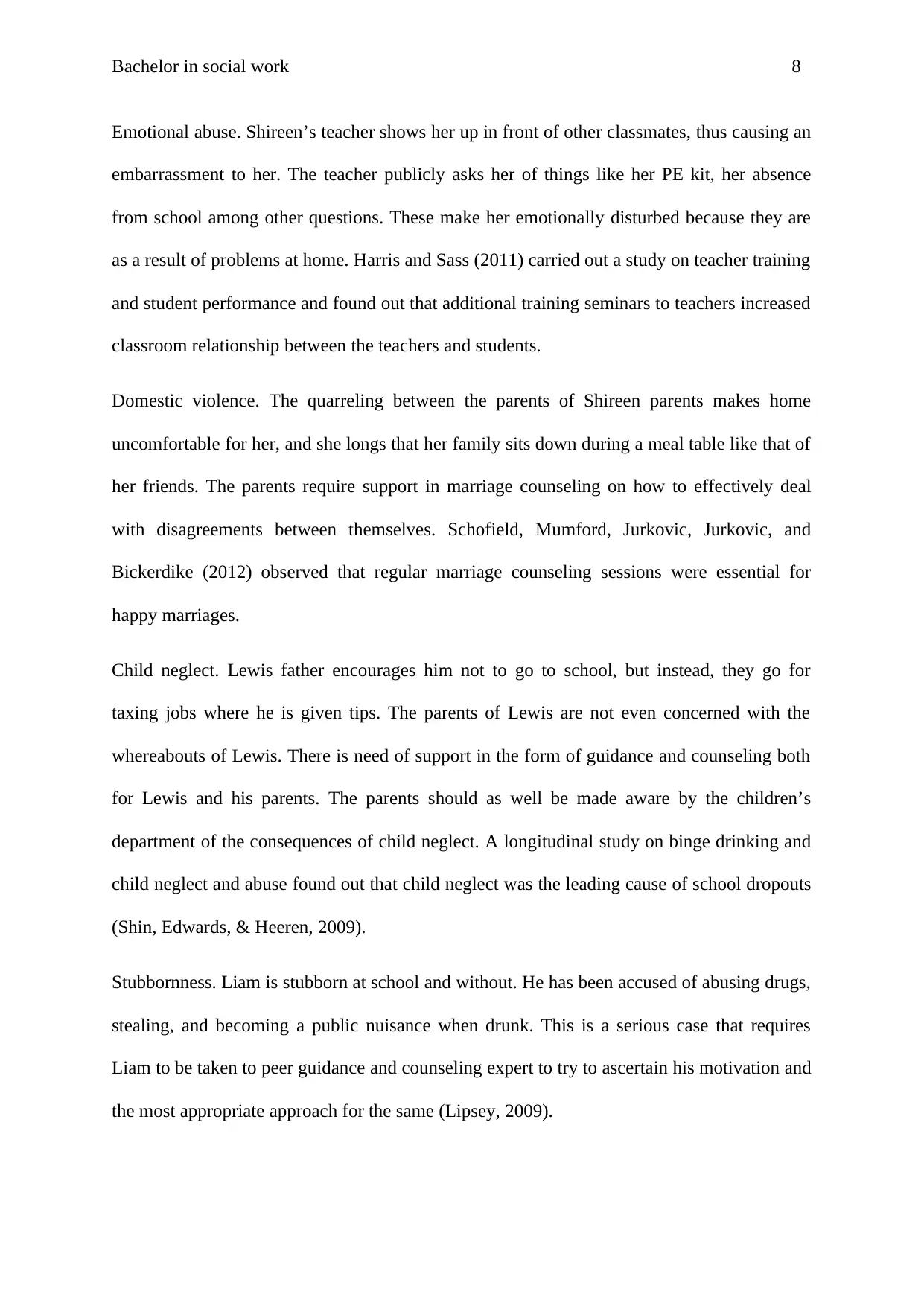
Bachelor in social work 8
Emotional abuse. Shireen’s teacher shows her up in front of other classmates, thus causing an
embarrassment to her. The teacher publicly asks her of things like her PE kit, her absence
from school among other questions. These make her emotionally disturbed because they are
as a result of problems at home. Harris and Sass (2011) carried out a study on teacher training
and student performance and found out that additional training seminars to teachers increased
classroom relationship between the teachers and students.
Domestic violence. The quarreling between the parents of Shireen parents makes home
uncomfortable for her, and she longs that her family sits down during a meal table like that of
her friends. The parents require support in marriage counseling on how to effectively deal
with disagreements between themselves. Schofield, Mumford, Jurkovic, Jurkovic, and
Bickerdike (2012) observed that regular marriage counseling sessions were essential for
happy marriages.
Child neglect. Lewis father encourages him not to go to school, but instead, they go for
taxing jobs where he is given tips. The parents of Lewis are not even concerned with the
whereabouts of Lewis. There is need of support in the form of guidance and counseling both
for Lewis and his parents. The parents should as well be made aware by the children’s
department of the consequences of child neglect. A longitudinal study on binge drinking and
child neglect and abuse found out that child neglect was the leading cause of school dropouts
(Shin, Edwards, & Heeren, 2009).
Stubbornness. Liam is stubborn at school and without. He has been accused of abusing drugs,
stealing, and becoming a public nuisance when drunk. This is a serious case that requires
Liam to be taken to peer guidance and counseling expert to try to ascertain his motivation and
the most appropriate approach for the same (Lipsey, 2009).
Emotional abuse. Shireen’s teacher shows her up in front of other classmates, thus causing an
embarrassment to her. The teacher publicly asks her of things like her PE kit, her absence
from school among other questions. These make her emotionally disturbed because they are
as a result of problems at home. Harris and Sass (2011) carried out a study on teacher training
and student performance and found out that additional training seminars to teachers increased
classroom relationship between the teachers and students.
Domestic violence. The quarreling between the parents of Shireen parents makes home
uncomfortable for her, and she longs that her family sits down during a meal table like that of
her friends. The parents require support in marriage counseling on how to effectively deal
with disagreements between themselves. Schofield, Mumford, Jurkovic, Jurkovic, and
Bickerdike (2012) observed that regular marriage counseling sessions were essential for
happy marriages.
Child neglect. Lewis father encourages him not to go to school, but instead, they go for
taxing jobs where he is given tips. The parents of Lewis are not even concerned with the
whereabouts of Lewis. There is need of support in the form of guidance and counseling both
for Lewis and his parents. The parents should as well be made aware by the children’s
department of the consequences of child neglect. A longitudinal study on binge drinking and
child neglect and abuse found out that child neglect was the leading cause of school dropouts
(Shin, Edwards, & Heeren, 2009).
Stubbornness. Liam is stubborn at school and without. He has been accused of abusing drugs,
stealing, and becoming a public nuisance when drunk. This is a serious case that requires
Liam to be taken to peer guidance and counseling expert to try to ascertain his motivation and
the most appropriate approach for the same (Lipsey, 2009).
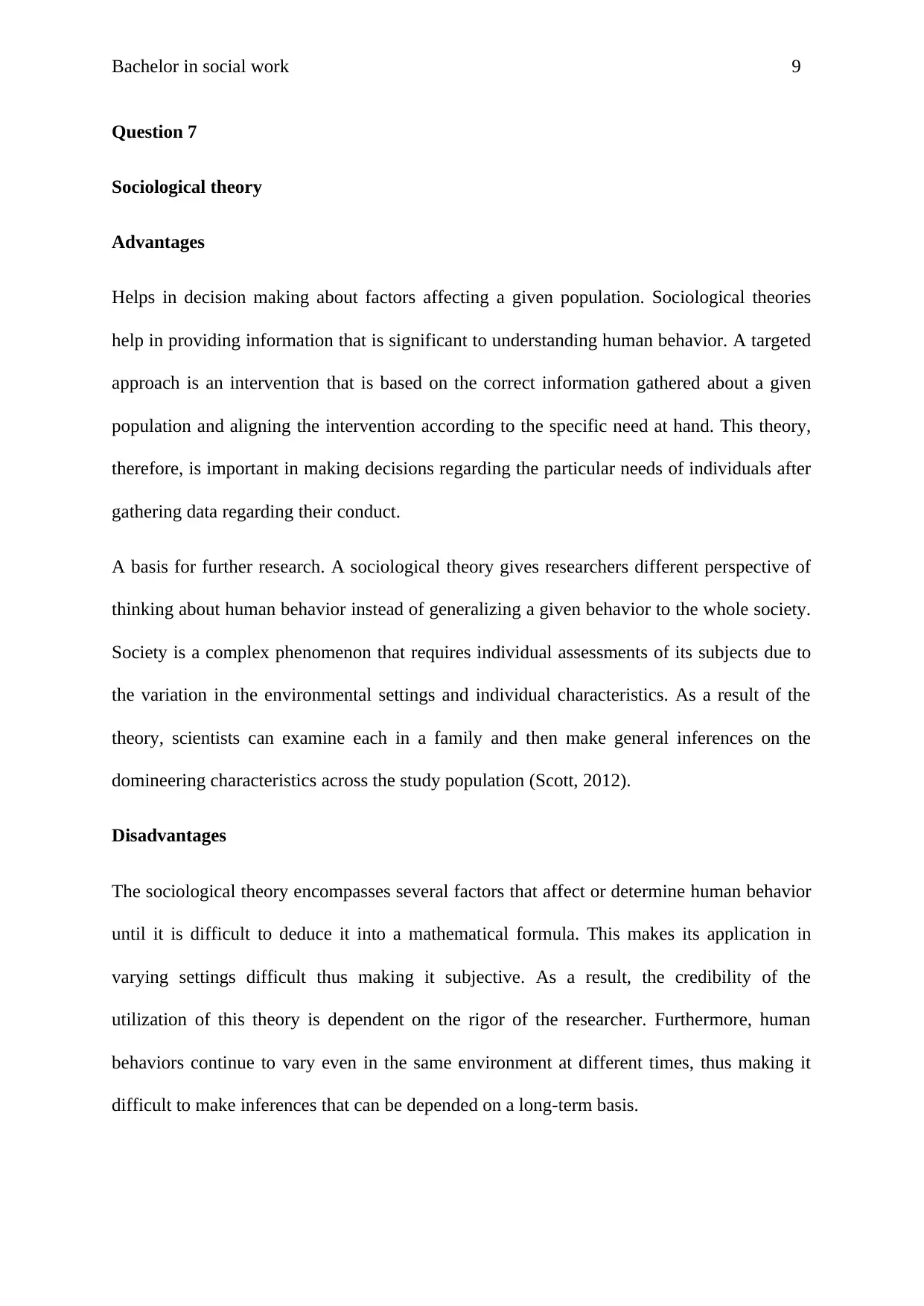
Bachelor in social work 9
Question 7
Sociological theory
Advantages
Helps in decision making about factors affecting a given population. Sociological theories
help in providing information that is significant to understanding human behavior. A targeted
approach is an intervention that is based on the correct information gathered about a given
population and aligning the intervention according to the specific need at hand. This theory,
therefore, is important in making decisions regarding the particular needs of individuals after
gathering data regarding their conduct.
A basis for further research. A sociological theory gives researchers different perspective of
thinking about human behavior instead of generalizing a given behavior to the whole society.
Society is a complex phenomenon that requires individual assessments of its subjects due to
the variation in the environmental settings and individual characteristics. As a result of the
theory, scientists can examine each in a family and then make general inferences on the
domineering characteristics across the study population (Scott, 2012).
Disadvantages
The sociological theory encompasses several factors that affect or determine human behavior
until it is difficult to deduce it into a mathematical formula. This makes its application in
varying settings difficult thus making it subjective. As a result, the credibility of the
utilization of this theory is dependent on the rigor of the researcher. Furthermore, human
behaviors continue to vary even in the same environment at different times, thus making it
difficult to make inferences that can be depended on a long-term basis.
Question 7
Sociological theory
Advantages
Helps in decision making about factors affecting a given population. Sociological theories
help in providing information that is significant to understanding human behavior. A targeted
approach is an intervention that is based on the correct information gathered about a given
population and aligning the intervention according to the specific need at hand. This theory,
therefore, is important in making decisions regarding the particular needs of individuals after
gathering data regarding their conduct.
A basis for further research. A sociological theory gives researchers different perspective of
thinking about human behavior instead of generalizing a given behavior to the whole society.
Society is a complex phenomenon that requires individual assessments of its subjects due to
the variation in the environmental settings and individual characteristics. As a result of the
theory, scientists can examine each in a family and then make general inferences on the
domineering characteristics across the study population (Scott, 2012).
Disadvantages
The sociological theory encompasses several factors that affect or determine human behavior
until it is difficult to deduce it into a mathematical formula. This makes its application in
varying settings difficult thus making it subjective. As a result, the credibility of the
utilization of this theory is dependent on the rigor of the researcher. Furthermore, human
behaviors continue to vary even in the same environment at different times, thus making it
difficult to make inferences that can be depended on a long-term basis.
⊘ This is a preview!⊘
Do you want full access?
Subscribe today to unlock all pages.

Trusted by 1+ million students worldwide
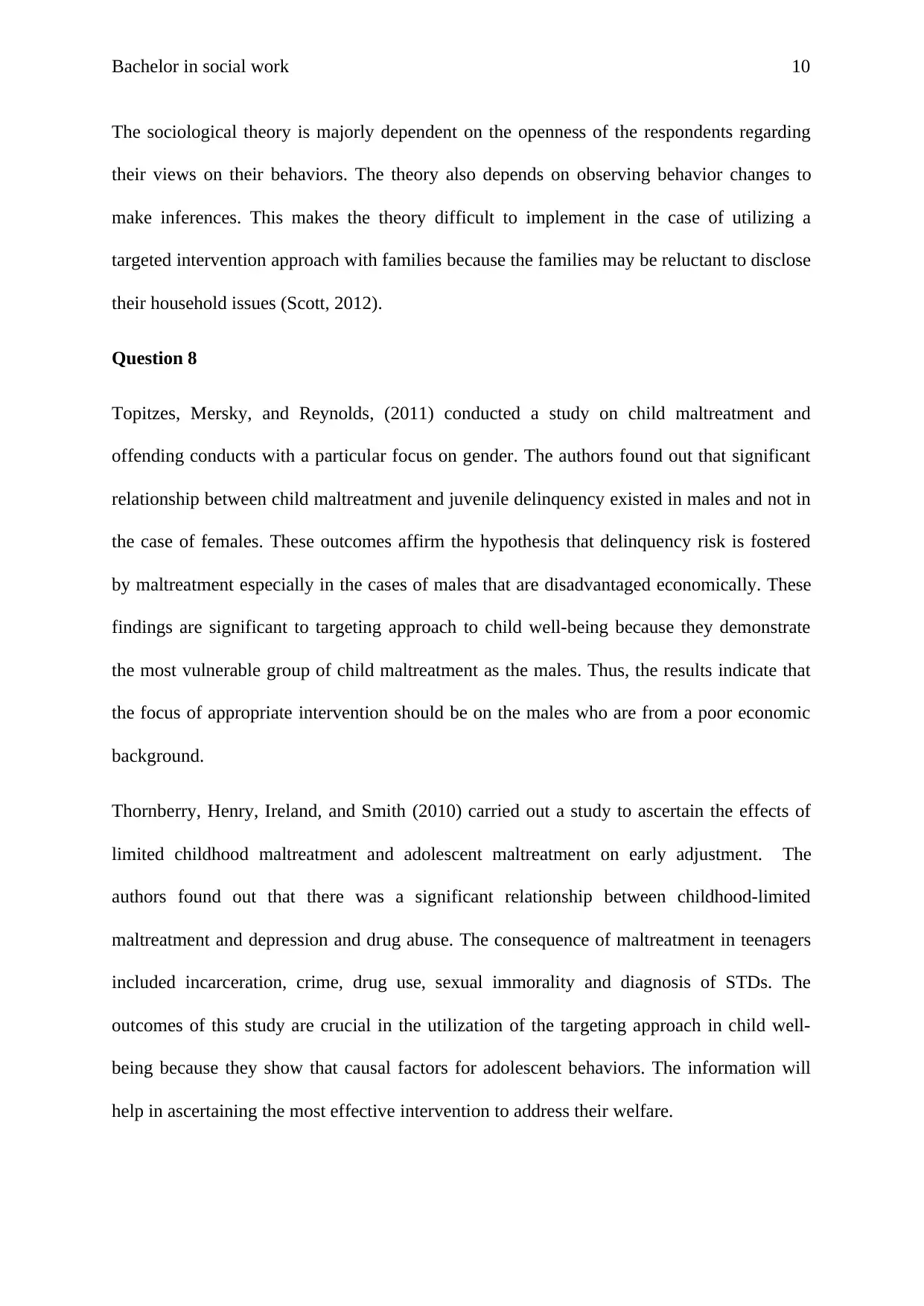
Bachelor in social work 10
The sociological theory is majorly dependent on the openness of the respondents regarding
their views on their behaviors. The theory also depends on observing behavior changes to
make inferences. This makes the theory difficult to implement in the case of utilizing a
targeted intervention approach with families because the families may be reluctant to disclose
their household issues (Scott, 2012).
Question 8
Topitzes, Mersky, and Reynolds, (2011) conducted a study on child maltreatment and
offending conducts with a particular focus on gender. The authors found out that significant
relationship between child maltreatment and juvenile delinquency existed in males and not in
the case of females. These outcomes affirm the hypothesis that delinquency risk is fostered
by maltreatment especially in the cases of males that are disadvantaged economically. These
findings are significant to targeting approach to child well-being because they demonstrate
the most vulnerable group of child maltreatment as the males. Thus, the results indicate that
the focus of appropriate intervention should be on the males who are from a poor economic
background.
Thornberry, Henry, Ireland, and Smith (2010) carried out a study to ascertain the effects of
limited childhood maltreatment and adolescent maltreatment on early adjustment. The
authors found out that there was a significant relationship between childhood-limited
maltreatment and depression and drug abuse. The consequence of maltreatment in teenagers
included incarceration, crime, drug use, sexual immorality and diagnosis of STDs. The
outcomes of this study are crucial in the utilization of the targeting approach in child well-
being because they show that causal factors for adolescent behaviors. The information will
help in ascertaining the most effective intervention to address their welfare.
The sociological theory is majorly dependent on the openness of the respondents regarding
their views on their behaviors. The theory also depends on observing behavior changes to
make inferences. This makes the theory difficult to implement in the case of utilizing a
targeted intervention approach with families because the families may be reluctant to disclose
their household issues (Scott, 2012).
Question 8
Topitzes, Mersky, and Reynolds, (2011) conducted a study on child maltreatment and
offending conducts with a particular focus on gender. The authors found out that significant
relationship between child maltreatment and juvenile delinquency existed in males and not in
the case of females. These outcomes affirm the hypothesis that delinquency risk is fostered
by maltreatment especially in the cases of males that are disadvantaged economically. These
findings are significant to targeting approach to child well-being because they demonstrate
the most vulnerable group of child maltreatment as the males. Thus, the results indicate that
the focus of appropriate intervention should be on the males who are from a poor economic
background.
Thornberry, Henry, Ireland, and Smith (2010) carried out a study to ascertain the effects of
limited childhood maltreatment and adolescent maltreatment on early adjustment. The
authors found out that there was a significant relationship between childhood-limited
maltreatment and depression and drug abuse. The consequence of maltreatment in teenagers
included incarceration, crime, drug use, sexual immorality and diagnosis of STDs. The
outcomes of this study are crucial in the utilization of the targeting approach in child well-
being because they show that causal factors for adolescent behaviors. The information will
help in ascertaining the most effective intervention to address their welfare.
Paraphrase This Document
Need a fresh take? Get an instant paraphrase of this document with our AI Paraphraser
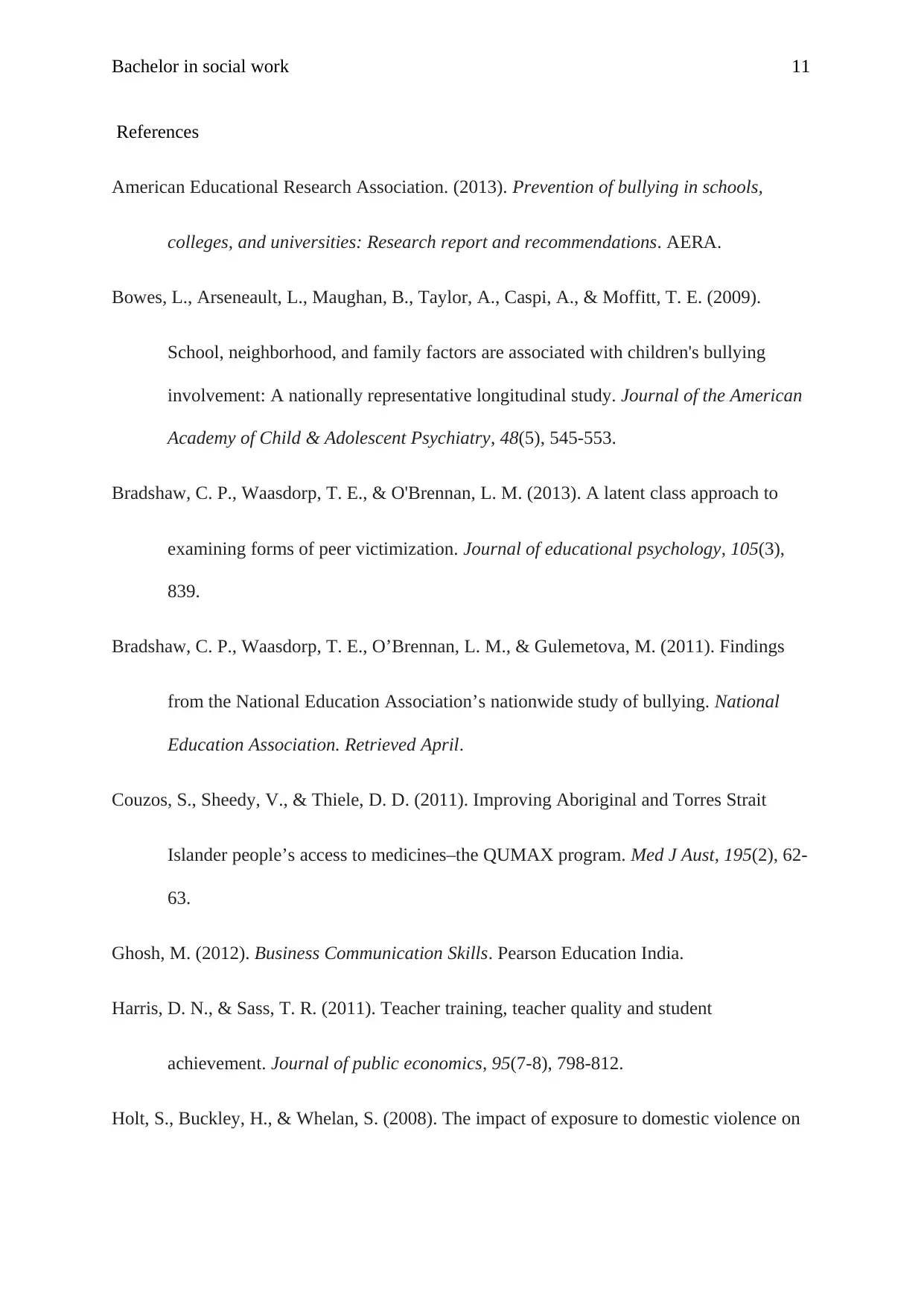
Bachelor in social work 11
References
American Educational Research Association. (2013). Prevention of bullying in schools,
colleges, and universities: Research report and recommendations. AERA.
Bowes, L., Arseneault, L., Maughan, B., Taylor, A., Caspi, A., & Moffitt, T. E. (2009).
School, neighborhood, and family factors are associated with children's bullying
involvement: A nationally representative longitudinal study. Journal of the American
Academy of Child & Adolescent Psychiatry, 48(5), 545-553.
Bradshaw, C. P., Waasdorp, T. E., & O'Brennan, L. M. (2013). A latent class approach to
examining forms of peer victimization. Journal of educational psychology, 105(3),
839.
Bradshaw, C. P., Waasdorp, T. E., O’Brennan, L. M., & Gulemetova, M. (2011). Findings
from the National Education Association’s nationwide study of bullying. National
Education Association. Retrieved April.
Couzos, S., Sheedy, V., & Thiele, D. D. (2011). Improving Aboriginal and Torres Strait
Islander people’s access to medicines–the QUMAX program. Med J Aust, 195(2), 62-
63.
Ghosh, M. (2012). Business Communication Skills. Pearson Education India.
Harris, D. N., & Sass, T. R. (2011). Teacher training, teacher quality and student
achievement. Journal of public economics, 95(7-8), 798-812.
Holt, S., Buckley, H., & Whelan, S. (2008). The impact of exposure to domestic violence on
References
American Educational Research Association. (2013). Prevention of bullying in schools,
colleges, and universities: Research report and recommendations. AERA.
Bowes, L., Arseneault, L., Maughan, B., Taylor, A., Caspi, A., & Moffitt, T. E. (2009).
School, neighborhood, and family factors are associated with children's bullying
involvement: A nationally representative longitudinal study. Journal of the American
Academy of Child & Adolescent Psychiatry, 48(5), 545-553.
Bradshaw, C. P., Waasdorp, T. E., & O'Brennan, L. M. (2013). A latent class approach to
examining forms of peer victimization. Journal of educational psychology, 105(3),
839.
Bradshaw, C. P., Waasdorp, T. E., O’Brennan, L. M., & Gulemetova, M. (2011). Findings
from the National Education Association’s nationwide study of bullying. National
Education Association. Retrieved April.
Couzos, S., Sheedy, V., & Thiele, D. D. (2011). Improving Aboriginal and Torres Strait
Islander people’s access to medicines–the QUMAX program. Med J Aust, 195(2), 62-
63.
Ghosh, M. (2012). Business Communication Skills. Pearson Education India.
Harris, D. N., & Sass, T. R. (2011). Teacher training, teacher quality and student
achievement. Journal of public economics, 95(7-8), 798-812.
Holt, S., Buckley, H., & Whelan, S. (2008). The impact of exposure to domestic violence on
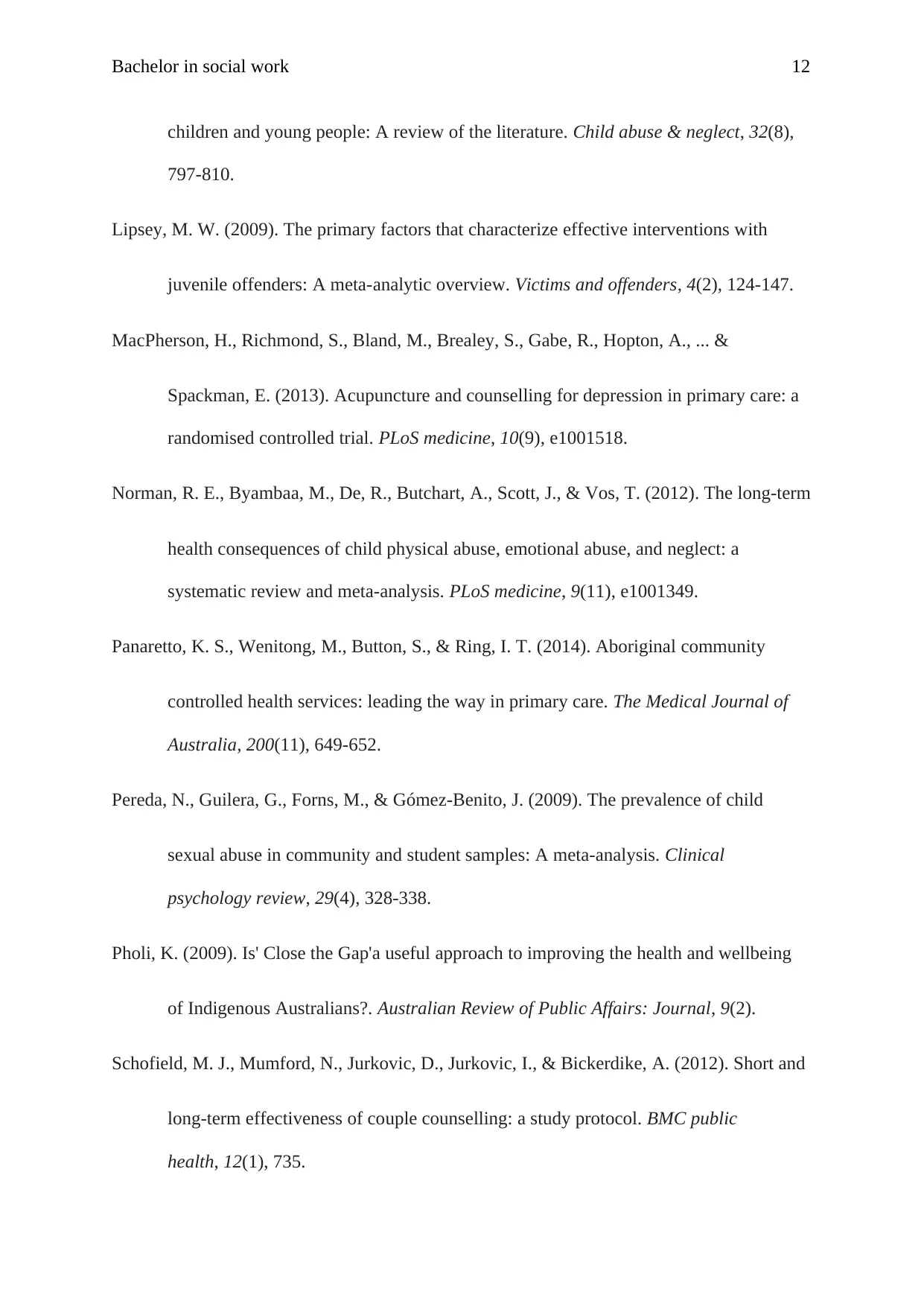
Bachelor in social work 12
children and young people: A review of the literature. Child abuse & neglect, 32(8),
797-810.
Lipsey, M. W. (2009). The primary factors that characterize effective interventions with
juvenile offenders: A meta-analytic overview. Victims and offenders, 4(2), 124-147.
MacPherson, H., Richmond, S., Bland, M., Brealey, S., Gabe, R., Hopton, A., ... &
Spackman, E. (2013). Acupuncture and counselling for depression in primary care: a
randomised controlled trial. PLoS medicine, 10(9), e1001518.
Norman, R. E., Byambaa, M., De, R., Butchart, A., Scott, J., & Vos, T. (2012). The long-term
health consequences of child physical abuse, emotional abuse, and neglect: a
systematic review and meta-analysis. PLoS medicine, 9(11), e1001349.
Panaretto, K. S., Wenitong, M., Button, S., & Ring, I. T. (2014). Aboriginal community
controlled health services: leading the way in primary care. The Medical Journal of
Australia, 200(11), 649-652.
Pereda, N., Guilera, G., Forns, M., & Gómez-Benito, J. (2009). The prevalence of child
sexual abuse in community and student samples: A meta-analysis. Clinical
psychology review, 29(4), 328-338.
Pholi, K. (2009). Is' Close the Gap'a useful approach to improving the health and wellbeing
of Indigenous Australians?. Australian Review of Public Affairs: Journal, 9(2).
Schofield, M. J., Mumford, N., Jurkovic, D., Jurkovic, I., & Bickerdike, A. (2012). Short and
long-term effectiveness of couple counselling: a study protocol. BMC public
health, 12(1), 735.
children and young people: A review of the literature. Child abuse & neglect, 32(8),
797-810.
Lipsey, M. W. (2009). The primary factors that characterize effective interventions with
juvenile offenders: A meta-analytic overview. Victims and offenders, 4(2), 124-147.
MacPherson, H., Richmond, S., Bland, M., Brealey, S., Gabe, R., Hopton, A., ... &
Spackman, E. (2013). Acupuncture and counselling for depression in primary care: a
randomised controlled trial. PLoS medicine, 10(9), e1001518.
Norman, R. E., Byambaa, M., De, R., Butchart, A., Scott, J., & Vos, T. (2012). The long-term
health consequences of child physical abuse, emotional abuse, and neglect: a
systematic review and meta-analysis. PLoS medicine, 9(11), e1001349.
Panaretto, K. S., Wenitong, M., Button, S., & Ring, I. T. (2014). Aboriginal community
controlled health services: leading the way in primary care. The Medical Journal of
Australia, 200(11), 649-652.
Pereda, N., Guilera, G., Forns, M., & Gómez-Benito, J. (2009). The prevalence of child
sexual abuse in community and student samples: A meta-analysis. Clinical
psychology review, 29(4), 328-338.
Pholi, K. (2009). Is' Close the Gap'a useful approach to improving the health and wellbeing
of Indigenous Australians?. Australian Review of Public Affairs: Journal, 9(2).
Schofield, M. J., Mumford, N., Jurkovic, D., Jurkovic, I., & Bickerdike, A. (2012). Short and
long-term effectiveness of couple counselling: a study protocol. BMC public
health, 12(1), 735.
⊘ This is a preview!⊘
Do you want full access?
Subscribe today to unlock all pages.

Trusted by 1+ million students worldwide
1 out of 13
Related Documents
Your All-in-One AI-Powered Toolkit for Academic Success.
+13062052269
info@desklib.com
Available 24*7 on WhatsApp / Email
![[object Object]](/_next/static/media/star-bottom.7253800d.svg)
Unlock your academic potential
Copyright © 2020–2025 A2Z Services. All Rights Reserved. Developed and managed by ZUCOL.




